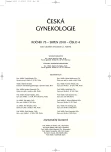Ethics in neonatal intensive care
Authors:
J. Macko
Authors‘ workplace:
Novorozenecké oddělení, Krajská nemocnice T. Bati, a. s., Zlín, primář MUDr. J. Macko
Published in:
Ceska Gynekol 2010; 75(4): 268-274
Overview
Work summarises current data ideas of problems of ethical thinking and decision making in neonatology. Primary objective ethical questions of administration resuscitative and intensive care are outlined, as well as administration of care for babies, delivered on limit of viability, in the same way for children with high probability of serious damage in case of survival. Role of parents in decision making about to other administration care is discussed, some recommendation and instructions for communication with parents are handed up. Findings of extensive european study named EURONIC are shortly mentioned, study concerns problems of ethical dilemmas in neonatology in 8 European countries. Finally the categorization of newborns in ethical thinking is mentioned and present circumstances in Czech republic are remarked.
Key words:
neonatal intensive care, ethics, withholding of care, withdrawing of care.
Sources
1. Ethics of intensive neonatal care. Editorial. Lancet 1999, 355, 9198.
2. Su, A., Mason, P., Allmark J., for the Euricon Study Group, Obtaining informed consent to neonatal randomised controlled trials: interviews with parents and clinicians in the Euricon study. Lancet 2000, 356.
3. Sauer PJ. and the members of the working group. Ethical dillemas in neonatology: recommendations of the Ethics Working Group of the CESP. Eur J Pediatr 2001, 160, p. 364–368.
4. Gilmer T., Schneiderman LJ., Teetzei H., et al. The costs of nonbeneficial treatment in the intensive care setting. Health Affairs 2005, 24, 4, p. 961–967.
5. Schroeder, SA. The legacy of SUPPORT: Study to understand prognoses and preferences for outcomes and risks of treatment. Ann Inter Med 1999, 131, 10, p. 780–782.
6. Arlettaz, R., Mieth, D., Bucher, HU., et al. End-of-life decisions in delivery room and neonatal intensive care unit. Acta Paediat, 2005, 94, p. 1626–1631.
7. Taylor, I., Ryan, CA., Byme, P., et al. No resuscitation and withdrawal of therapy in a neonatal and a pediatric intensive care unit in Canada. J Pediatr 1993, 23, p. 534-538.
8. Young, EWD., Stevenson, DK. Limiting treatment for extremely premature, low-birth-weight infants (500 to 750 g). Am J Dis Child 1990, 144, p. 549-552.
9. Chiswick, M. Parents and end of life decisions in neonatal practice. Arch Dis Child Fetal Neonatal Ed 2001, 85, p. Fl-F3.
10. McHaffie, HE., Lyon, AJ., Fowlie, PW. Lingering death after treatment withdrawal in the neonatal intensive care unit. Arch Dis Child Fetal Neonatal Ed 2001, 85, p. F8-F12.
11. Sauer, PJJ. Ethical decisions in neonatal intensive care units: the Dutch experience. Pediatr 1992, 90, p. 729–732.
12. van der Heide, A., van der Maas, PJ., van der Wai, G., et al. Medical end-of-life decisions made for neonates and infants in the Netherlands. Lancet 1997, 350, p. 251–255.
13. Kopelman, AE. Understanding, avoiding, and resolving end-of-life conflicts in the NICU. Mount Sinai J Med 2006, 73, 3, p. 580–586.
14. Cook, LA., Watchko, JF. Decision making for the critically ill neonate near the end of life. J Perinatol 1996, 16(2 Pt1), p. 133–136.
15. Breen, CM., Abernethy, AP., Abbott, KH., Tulsky, JA. Conflict associated with decisions to limit life-sustaining treatment in intensive care units. J Gen Intern Med 2001, 16(5), p. 283–289.
16. Goold, SD., Williams, B., Arnold, RM. Conflicts regarding decisions to limit treatment: a differential diagnosis. JAMA 2000, 283, p. 909–914.
17. Levy, MM. End-of-life care in the intensive care unit: can we do better? Crit Care Med 2001, 29(2 Suppl), p. N5–N61.
18. Blank, LL. Overview on ABIM End-of-Life Patient Care Project: caring for the dying: identification and promotion of physician competency. Hosp J 1998, 13(1–2), p. 145–150.
19. Fine, RL., Mayo, TW. Resolution of futility by due process: early experience with the Texas Advance Directives Act. Ann Intern Med 2003, 138, p. 743–746.
Labels
Paediatric gynaecology Gynaecology and obstetrics Reproduction medicineArticle was published in
Czech Gynaecology

2010 Issue 4
Most read in this issue
- Shoulder dystocia during vaginal delivery
- Repair of the 3rd and 4th degree obstetric perineal tear
- Perinatal brachial plexus palsy
- Complications of radical oncogynecological operations
